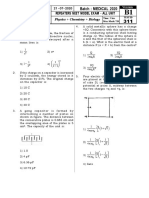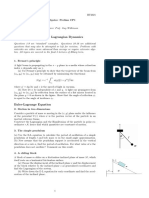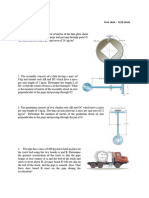0 ratings0% found this document useful (0 votes)
4 viewsTutorial9_Soln
Uploaded by
drdCopyright
© © All Rights Reserved
Available Formats
Download as PDF, TXT or read online on Scribd
0 ratings0% found this document useful (0 votes)
4 viewsTutorial9_Soln
Uploaded by
drdCopyright
© © All Rights Reserved
Available Formats
Download as PDF, TXT or read online on Scribd
You are on page 1/ 18
Department of Physics PHY 112-Tutorial 9
IIT Kanpur Jan-May 2016
Figure 1: Figure for problems 1, 2, 3 and 5.
1. Oscillations in coupled systems:– Three identical springs and two masses, m1 = m
and m2 = 2m, lie between two walls, as shown in Fig. 1 (a). For our case, it will help
to solve the general case of m2 = am, where a is a constant. Later, we will analyze the
di↵erent limits of a in the last part of this question.
(a) Use the Lagrangian to derive the coupled set of equations of motions for both
masses.
(b) Find the normal modes.
(c) Check the orthogonality of the normal mode eigenvectors.
(d) What happens to the motion as i) m2 ! m1 , ii) m2 ⌧ m1 , and as m2 m2 . Note
that m2 ⌧ m1 implies a ! 0, and m2 m1 implies a ! 1.
2. Noether’s theorem at work in Atwood’s machine:– Consider the Atwood’s ma-
chine shown in Fig. 1(b). The masses are 4m, 5m, and 3m. Let x and y be the heights
of the two masses on the right pully – relative to their initial positions, as shown in
Fig. 1(b). Use Noether’s theorem to find the conserved momentum.
3. Small oscillations:– The curve y(x) = b(x/a) is rotated around the y axis with
constant frequency ! [see Fig. 1(c)]. A bead moves frictionlessly along the curve. Find
the frequency of small oscillations about the equilibrium point. Under what conditions
do oscillations exist?
4. Lorentz Force:– Consider a charged particle q of mass m moving with a velocity v in a
electromagnetic field, specified by a scalar potential and a vector potential A. Let the
potential energy of the system be specified by U = q q v · A. Calculate the equation
of motion of the x-coordinate. If we express the equation of motion in the form,
mẍ = q(E + v ⇥ B)x , (1)
then what is the expression of E and B.
Phy112: Introduction to Dynamics Rohit Medwal, Amit Agarwal
Phy112 Page 2 of 2 Tutorial 9
5. Trajectory optimization - the brachistochrone problem:– A bead is released from
rest at the origin and slides down a frictionless wire that connects the origin to a given
point, as shown in Fig. 1(d). You want to shape the wire so that the bead reaches
the endpoint in the shortest possible time. Let the desired curve be described by the
function y(x), with downward taken to be positive.
(a) Show that y(x) satisfies
1 + y 02 = B/y , (2)
with B being a constant.
(b) Show that x and y may be written as x = a(✓ sin ✓) and y = a(1 cos ✓). This is
the parametrization of a cycloid, the path taken by a point on the rim of a rolling
wheel.
(c) In general, if f (y) is a function of y, then the function y which extremizes the
integral, Z p
dxf (y) 1 + y 02 , (3)
satisfies the equation
1 + y 02 = Bf (y)2 . (4)
You might also like
- Student Solutions Manual to Accompany Economic Dynamics in Discrete Time, secondeditionFrom EverandStudent Solutions Manual to Accompany Economic Dynamics in Discrete Time, secondedition4.5/5 (2)
- Physics M.SC - PHY4102 Classical Mechanics100% (4)Physics M.SC - PHY4102 Classical Mechanics19 pages
- 7 EFv NPBL RS9 BV 6 J 37 Ux LTZgiqa R6 E6 R 1 C Osu TRC XNo ratings yet7 EFv NPBL RS9 BV 6 J 37 Ux LTZgiqa R6 E6 R 1 C Osu TRC X18 pages
- Physics 251, Honours Classical Mechanics 1: Homework #6: M M K K X XNo ratings yetPhysics 251, Honours Classical Mechanics 1: Homework #6: M M K K X X2 pages
- CLASS 12 REPEATER BATCH PHYSICS PAPER_15-12-24No ratings yetCLASS 12 REPEATER BATCH PHYSICS PAPER_15-12-245 pages
- Comprehensive Examination (Closed Book) - Part ANo ratings yetComprehensive Examination (Closed Book) - Part A6 pages
- Fiitjee Phase Test 1 (Class XI), 16 Aug, 2020: Advanced Paper 2No ratings yetFiitjee Phase Test 1 (Class XI), 16 Aug, 2020: Advanced Paper 211 pages
- Brilliant: Repeaters Neet Model Exam - All UnitNo ratings yetBrilliant: Repeaters Neet Model Exam - All Unit40 pages
- Nodia and Company: Gate Solved Paper Mathematics MechanicsNo ratings yetNodia and Company: Gate Solved Paper Mathematics Mechanics8 pages
- Sri Chaitanya Physics PARAGRAPH Type Question BANKkkkkkkkkkkkkkkkkkkkkkkkkkkkkkkNo ratings yetSri Chaitanya Physics PARAGRAPH Type Question BANKkkkkkkkkkkkkkkkkkkkkkkkkkkkkkk61 pages
- UC Berkeley Classical Mechanics Prelims1984-2019No ratings yetUC Berkeley Classical Mechanics Prelims1984-201947 pages
- Phys 503 Classical Mechanics I Fall 2013 Midterm Exam #3 Due Sunday, December 8 (20% of Course Grade) (At Noon in TA's Mailbox)No ratings yetPhys 503 Classical Mechanics I Fall 2013 Midterm Exam #3 Due Sunday, December 8 (20% of Course Grade) (At Noon in TA's Mailbox)4 pages
- Solution Lagrangian One Degree of FreedomNo ratings yetSolution Lagrangian One Degree of Freedom3 pages
- Jee Advanced 2018 Paper 1 With Answer Physics PDFNo ratings yetJee Advanced 2018 Paper 1 With Answer Physics PDF6 pages
- 21-05-23 - Isr - Iit - Star Co-Sc (Model-A) - Jee Adv - 2019 (P-Ii) - Cat-17 - QPNo ratings yet21-05-23 - Isr - Iit - Star Co-Sc (Model-A) - Jee Adv - 2019 (P-Ii) - Cat-17 - QP24 pages
- PHY293H1 20119 621381278039phy293 Midterm 2011 Solutions PDFNo ratings yetPHY293H1 20119 621381278039phy293 Midterm 2011 Solutions PDF5 pages
- Exercises Set 02. Classical Wave EquationNo ratings yetExercises Set 02. Classical Wave Equation5 pages
- Please: Grade Them Efficiently by Following The Above Simple Instructions!!! Failure To Follow Them May Result in A Lower Grade!! Thank You!!No ratings yetPlease: Grade Them Efficiently by Following The Above Simple Instructions!!! Failure To Follow Them May Result in A Lower Grade!! Thank You!!3 pages
- 2018 QUALS - Section 1 - Classical Mechanics With SolutionsNo ratings yet2018 QUALS - Section 1 - Classical Mechanics With Solutions17 pages
- Lecture Notes On Classical Mechanics (PDFDrive)No ratings yetLecture Notes On Classical Mechanics (PDFDrive)463 pages
- Problems in Quantum Mechanics: Third EditionFrom EverandProblems in Quantum Mechanics: Third EditionD. ter Haar3/5 (2)
- K. v. Narayanan, B. Lakshmikutty - Stoichiometry and Process Calculations-PHI Learning (2017)No ratings yetK. v. Narayanan, B. Lakshmikutty - Stoichiometry and Process Calculations-PHI Learning (2017)613 pages
- Maths Class X Chapter 09 Some Applications of Trigonometry Practice Paper 11 2024 AnswersNo ratings yetMaths Class X Chapter 09 Some Applications of Trigonometry Practice Paper 11 2024 Answers8 pages
- Chapter-04-Applications-Thermodynamics-Earth 4744 0 PDFNo ratings yetChapter-04-Applications-Thermodynamics-Earth 4744 0 PDF43 pages
- Instant ebooks textbook (eBook PDF) Frommer's Radiology for the Dental Professional - E-Book 10th Edition download all chapters100% (2)Instant ebooks textbook (eBook PDF) Frommer's Radiology for the Dental Professional - E-Book 10th Edition download all chapters51 pages
- Development of Load Spectrum For Full Scale Fatigue Test of A Trainer AircraftNo ratings yetDevelopment of Load Spectrum For Full Scale Fatigue Test of A Trainer Aircraft12 pages
- Assignment Isomerism & Stereochemistry-2023No ratings yetAssignment Isomerism & Stereochemistry-20233 pages
- MS For FOC Laying, Splicing, Termination, Testing and Commissioning Works50% (2)MS For FOC Laying, Splicing, Termination, Testing and Commissioning Works23 pages
- 293-1-Spc-002 Specification For Grouting, Rev. ANo ratings yet293-1-Spc-002 Specification For Grouting, Rev. A10 pages
- Science: Quarter 3 - Module 2: Magnetic Force100% (2)Science: Quarter 3 - Module 2: Magnetic Force23 pages
- Terminal Fan Coil Units: Product Guide 2018-2019No ratings yetTerminal Fan Coil Units: Product Guide 2018-201918 pages
- 2020 06 15 WEBSITE LAAA PDF Case Study DTM CoatingsNo ratings yet2020 06 15 WEBSITE LAAA PDF Case Study DTM Coatings11 pages
- Tech Note A Look Under The Hood of LunaticNo ratings yetTech Note A Look Under The Hood of Lunatic13 pages
- Numerical Modeling of Soil Nail Walls Considering Mohr Coulomb, Hardeninig SoilNo ratings yetNumerical Modeling of Soil Nail Walls Considering Mohr Coulomb, Hardeninig Soil11 pages
- Chapter 9 Alexanders Fundamentals of Electric Circuits Ch9 SolutionNo ratings yetChapter 9 Alexanders Fundamentals of Electric Circuits Ch9 Solution98 pages
- Student Solutions Manual to Accompany Economic Dynamics in Discrete Time, secondeditionFrom EverandStudent Solutions Manual to Accompany Economic Dynamics in Discrete Time, secondedition
- 7 EFv NPBL RS9 BV 6 J 37 Ux LTZgiqa R6 E6 R 1 C Osu TRC X7 EFv NPBL RS9 BV 6 J 37 Ux LTZgiqa R6 E6 R 1 C Osu TRC X
- Physics 251, Honours Classical Mechanics 1: Homework #6: M M K K X XPhysics 251, Honours Classical Mechanics 1: Homework #6: M M K K X X
- Fiitjee Phase Test 1 (Class XI), 16 Aug, 2020: Advanced Paper 2Fiitjee Phase Test 1 (Class XI), 16 Aug, 2020: Advanced Paper 2
- Nodia and Company: Gate Solved Paper Mathematics MechanicsNodia and Company: Gate Solved Paper Mathematics Mechanics
- Sri Chaitanya Physics PARAGRAPH Type Question BANKkkkkkkkkkkkkkkkkkkkkkkkkkkkkkkSri Chaitanya Physics PARAGRAPH Type Question BANKkkkkkkkkkkkkkkkkkkkkkkkkkkkkkk
- Phys 503 Classical Mechanics I Fall 2013 Midterm Exam #3 Due Sunday, December 8 (20% of Course Grade) (At Noon in TA's Mailbox)Phys 503 Classical Mechanics I Fall 2013 Midterm Exam #3 Due Sunday, December 8 (20% of Course Grade) (At Noon in TA's Mailbox)
- 21-05-23 - Isr - Iit - Star Co-Sc (Model-A) - Jee Adv - 2019 (P-Ii) - Cat-17 - QP21-05-23 - Isr - Iit - Star Co-Sc (Model-A) - Jee Adv - 2019 (P-Ii) - Cat-17 - QP
- PHY293H1 20119 621381278039phy293 Midterm 2011 Solutions PDFPHY293H1 20119 621381278039phy293 Midterm 2011 Solutions PDF
- Please: Grade Them Efficiently by Following The Above Simple Instructions!!! Failure To Follow Them May Result in A Lower Grade!! Thank You!!Please: Grade Them Efficiently by Following The Above Simple Instructions!!! Failure To Follow Them May Result in A Lower Grade!! Thank You!!
- 2018 QUALS - Section 1 - Classical Mechanics With Solutions2018 QUALS - Section 1 - Classical Mechanics With Solutions
- Problems in Quantum Mechanics: Third EditionFrom EverandProblems in Quantum Mechanics: Third Edition
- K. v. Narayanan, B. Lakshmikutty - Stoichiometry and Process Calculations-PHI Learning (2017)K. v. Narayanan, B. Lakshmikutty - Stoichiometry and Process Calculations-PHI Learning (2017)
- Maths Class X Chapter 09 Some Applications of Trigonometry Practice Paper 11 2024 AnswersMaths Class X Chapter 09 Some Applications of Trigonometry Practice Paper 11 2024 Answers
- Chapter-04-Applications-Thermodynamics-Earth 4744 0 PDFChapter-04-Applications-Thermodynamics-Earth 4744 0 PDF
- Instant ebooks textbook (eBook PDF) Frommer's Radiology for the Dental Professional - E-Book 10th Edition download all chaptersInstant ebooks textbook (eBook PDF) Frommer's Radiology for the Dental Professional - E-Book 10th Edition download all chapters
- Development of Load Spectrum For Full Scale Fatigue Test of A Trainer AircraftDevelopment of Load Spectrum For Full Scale Fatigue Test of A Trainer Aircraft
- MS For FOC Laying, Splicing, Termination, Testing and Commissioning WorksMS For FOC Laying, Splicing, Termination, Testing and Commissioning Works
- 2020 06 15 WEBSITE LAAA PDF Case Study DTM Coatings2020 06 15 WEBSITE LAAA PDF Case Study DTM Coatings
- Numerical Modeling of Soil Nail Walls Considering Mohr Coulomb, Hardeninig SoilNumerical Modeling of Soil Nail Walls Considering Mohr Coulomb, Hardeninig Soil
- Chapter 9 Alexanders Fundamentals of Electric Circuits Ch9 SolutionChapter 9 Alexanders Fundamentals of Electric Circuits Ch9 Solution

























































































